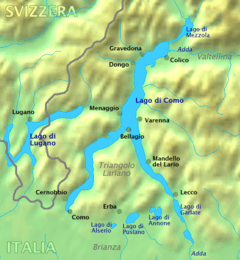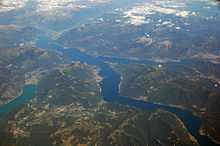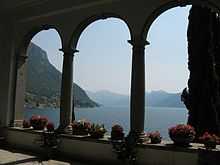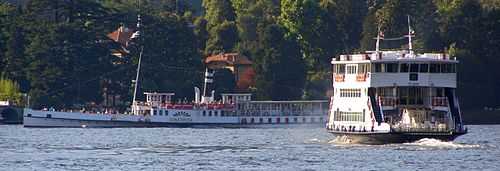Lake Como
| Lake Como | |
|---|---|
 Panoramic view of Lake Como with Grigna Mountains and Bellagio | |
 | |
| Location | Lombardy, Italy |
| Coordinates | 46°00′N 9°16′E / 46.000°N 9.267°ECoordinates: 46°00′N 9°16′E / 46.000°N 9.267°E |
| Primary inflows | Adda River, Mera River |
| Primary outflows | Adda River |
| Catchment area | 4,509 km2 (1,741 sq mi) [1] |
| Basin countries | Italy, Switzerland |
| Max. length | 46 km |
| Max. width | 4.5 km |
| Surface area | 146 km² |
| Average depth | 154 m [1] |
| Max. depth | 425 m |
| Water volume | 22.5 km³ |
| Residence time | 5.5 years [1] |
| Surface elevation | 198 m [1] |
| Islands | Isola Comacina |
| Settlements | Como, Lecco (see article) |
| References | [1] |
Lake Como (Lago di Como in Italian, also known as Lario, after the Latin name of the lake; Lach de Comm in Insubric; Latin: Larius Lacus) is a lake of glacial origin in Lombardy, Italy. It has an area of 146 square kilometres (56 sq mi), making it the third largest lake in Italy, after Lake Garda and Lake Maggiore. At over 400 metres (1,300 feet) deep, it is one of the deepest lakes in Europe, and the bottom of the lake is more than 200 metres (660 ft) below sea-level.
Lake Como has been a popular retreat for aristocrats and wealthy people since Roman times, and a very popular tourist attraction with many artistic and cultural gems. It has many villas and palaces (such as Villa Olmo, Villa Serbelloni, and Villa Carlotta). Many famous people have or have had homes on the shores of Lake Como, such as Matthew Bellamy, Madonna, George Clooney,[2] Gianni Versace, Ronaldinho, Sylvester Stallone, Julian Lennon, Richard Branson, Ben Spies, and Pierina Legnani. Lake Como is widely regarded as one of the most beautiful lakes in Europe.[3]
Etymology
The lake's name in Latin is Larius, Italianised as Lario, but this name is rarely used; it is usually called Lago di Como (literally "Lake of Como"). In guidebooks the lake may be variously described as "Lake Como", "Lake of Como", or "Como Lake." Its name comes from the town of Como, known to the Romans as Comum.
While the town of Como is referred to as "Como", the lake itself is never referred to solely by this name. (This is not true of another lake in Italy, Lake Garda, where "Garda" may refer to either a town on its shores, or the lake.)
Geography

The lake is shaped much like the character "Y". The northern branch begins at the town of Colico, while the towns of Como and Lecco sit at the ends of the southwestern and southeastern branches respectively. The small towns of Bellagio, Menaggio, and Varenna are situated at the intersection of the three branches of the lake: a triangular boat service operates between them.
Lake Como is fed in large part by the Adda River, which enters the lake near Colico and flows out at Lecco. This geological conformation makes the southwestern branch a dead end, and so Como, unlike Lecco, is often flooded.
The mountainous pre-alpine territory between the two southern arms of the lake—between Como, Bellagio, and Lecco—is known as the Larian Triangle, or Triangolo lariano. The source of the river Lambro is here. At the centre of the triangle, the town of Canzo is the seat of the Comunità montana del Triangolo Lariano, an association of the 31 municipalities that represent the 71,000 inhabitants of the area.
Climate
Lake Como weather is generally mild. It is known for its Mediterranean-like climate where tropical and sub-tropical plants can grow year-round.[citation needed] In the winter, the lake helps to maintain a higher temperature in the surrounding region. Average daily temperatures range from about 2 °C (36 °F) in January to 30 °C (86 °F) in July.[citation needed] Water temperatures can reach an average of 24 °C (75 °F) during the month of July. Snowfall is erratic and primarily affects the higher elevations. Rainfall is heaviest in May and lowest during the winter months.
Tourism
As a tourist destination, Lake Como is popular for its landscapes, wildlife, and spas.[4] It is a venue for sailing, windsurfing, and kitesurfing.[5] In 1818 Percy Bysshe Shelley wrote to Thomas Love Peacock: "This lake exceeds anything I ever beheld in beauty, with the exception of the arbutus islands of Killarney. It is long and narrow, and has the appearance of a mighty river winding among the mountains and the forests".[6]
Lakeside villas
_-_DSC02504.JPG)
_-_DSC02854.JPG)


The lake is well known for the attractive villas that have been built there since Roman times, when Pliny the Younger built the Comedia and the Tragedia resorts. Many villas on the lake shores have admirable gardens that benefit from the mild climate induced by the stabilising presence of 22.5 km³ of lake water and are fit to host tropical plants.
Villa Carlotta was built for the Milanese Marquis Giorgio Clerici in 1690 and occupies a site of over 70,000 m2 (753,474 sq ft) at Tremezzo, facing the Bellagio peninsula. An Italian garden, with steps, fountains, and sculptures, was laid out at the same time. The villa was later sold to powerful banker and Napoleonic politician Giovanni Battista Sommariva. Stendhal was his guest in 1818, and his visit is recalled at the start of La Chartreuse de Parme. In 1843 it was purchased by Princess Marianne of Nassau as a wedding present for her daughter Carlotta, after whom the villa is now named. The latter, together with her husband Georg II of Saxen-Meiningen, laid out the woodland landscape park in Romantic style. The villa today includes a museum of agricultural implements as well as important works of sculpture by Sommariva’s friend Antonio Canova and by Luigi Acquisti.[7]
Villa d'Este, in Cernobbio, was built in 1568 by Cardinal Tolomeo Gallio, a native of the town. In 1816–17 the villa was home to Caroline of Brunswick, estranged wife of the Prince of Wales and shortly to become Queen Consort of King George IV of the United Kingdom. The landscaped gardens in the English style are a product of this period. Later in the century it was turned into a luxury hotel. Today the Villa d’Este is known for attracting celebrity guests.
Villa del Balbianello, famous for its elaborate terraced gardens, lies on a promontory of the western shore of the lake near Isola Comacina. Built in 1787 on the site of a Franciscan monastery, it was the final home of the explorer Guido Monzino and today houses a museum devoted to his work.
Villa Melzi d'Eril in Bellagio was built in neo-classical style by architect Giocondo Albertolli in 1808–10 as the summer residence of Duke Francesco Melzi d'Eril, who was vice-president of the Napoleonic Italian Republic. The park includes an orangery, a private chapel, fine statues, and a Japanese garden, and is planted, as often on lake Como, with huge rhododendrons. 19th-century guests at the Villa included Stendhal and Franz Liszt.[8]
Villa Serbelloni, also in Bellagio, hosts the Rockfeller Foundation Bellagio Center, a 50-acre (200,000 m2) international conference center set up and managed by the Rockefeller Foundation since 1959, which also operates a "scholar-in-residence" program for scholars from around the world. This is believed to have been the site of Pliny the Younger’s villa "Tragedia". Its well-known park was created at the end of the 18th century by Alessandro Serbelloni.
Ferries
The Lake Como ferry service is a highly developed public transport system linking the dozens of small towns and villages dotted around the perimeter of the Lake. A motorized service began in 1826 when a steamship with sails, the “Lario”, was launched by the newly established Società privilegiata per l'impresa dei battelli a vapore nel Regno Lombardo Veneto. Since 1952 the system has been run under the auspices of a government organization called first the Gestione Commissariale Governativa and subsequently the Gestione Governativa Navigazione Laghi, which is also responsible for services on Lake Maggiore and Lake Garda.[9][10]
Today there are three main services:
- "Motorship" services up and down the western branch and northern end of the Lake (between Colico or Piona and Como town), with additional shuttles to the mid-lake area.
- "Fast services" that follow broadly the same route but use quicker hydrofoils, stop less frequently, and cost extra.
- "Ferries" that run only between the hugely popular mid-lake villages of Menaggio, Bellagio, and Varenna, plus Cadenabbia. Some of these boats carry vehicles as well as passengers.[11]

Sacro Monte di Ossuccio

The Sacro Monte di Ossuccio ("Holy Mount of Ossuccio") is a sanctuary located on a hillside slope between olive groves and woods along the western edge of Lake Como facing Isola Comacina. Fifteen Baroque inspired chapels, built between 1635 and 1710, and dedicated to the Mysteries of the Rosary are dotted along the way that leads to the Monastery. This building is the last in the chain and is dedicated to the Coronation of the Virgin. In 2003, the Sacri Monti of Piedmont and Lombardy, including that of Ossuccio, were added by UNESCO to the World Heritage List.
Villages, resorts and other remarkable localities near the lake
.jpg)
| Western shore from North to South |
South shore from West to East |
Eastern shore from North to South |
|---|---|---|
|
|
References in literature

- Ernst Stavro Blofeld retreats to a 'metropolitan hotel' in Lake Como after his plans are foiled by James Bond in the novel On Her Majesty's Secret Service by Ian Fleming.
- Gaius Catullus asks his friend Caecilius to depart from Lake Como to Rome in poem 35.
- Paul the Deacon, a Lombard grammarian and poet of the 8th century, wrote one of his better known poems in praise of Lake Como (Versus in Laude Larii Laci).[12]
- Alessandro Manzoni chose to start his The Betrothed with a graphic description of Lake Como.
- Fabrice del Dongo, the protagonist of The Charterhouse of Parma by Stendhal, is born and raised near Lake Como.
- Mark Twain visited Lake Como in the summer of 1867. He describes the lake and its environs at length in The Innocents Abroad, which recounts a lengthy pleasure excursion to Jerusalem.
- The character of Victor Frankenstein marries Elizabeth in the vicinity of Lake Como in the novel by Mary Shelley.
- The lake is referenced by Jean in August Strindberg's magnum opus play Miss Julie.
- Ernest Hemingway's character Lieutenant Henry in A Farewell to Arms talks about taking a vacation to Lake Como.
- Fyodor Dostoevsky mentions Lake Como in his novel Notes from Underground.
- Nagg and Nell recollect rowing out onto Lake Como the day after their engagement in Samuel Beckett's play Endgame.
- Cadenabbia on Lake Como is the principal setting for Gladys Theodora Parrish Huntingdon's novel Madame Solario.
- Maria Ruskin, a character in Tom Wolfe's Bonfire of the Vanities, escapes from New York to Lake Como, in order to spend time with Artist Filipo Chirazzi.
Depictions in popular culture
- The 1995 movie A Month by the Lake was filmed in various locations around Lake Como.
- Star Wars Episode II: Attack of the Clones (2002 film): Some of the scenes that take place on planet Naboo were shot at Villa del Balbianello, including the clandestine marriage of Anakin Skywalker and Padmé Amidala.
- In the film Ocean's Twelve, the infamous thief Francois Toulour, a.k.a. The Night Fox, resides in the Villa Erba estate in Lake Como, where he has several encounters with Daniel Ocean, his rival thief.
- Locations around Lake Como appear several times in the James Bond movie Casino Royale: Villa del Balbianello plays the hospital where James Bond recuperates, and in the final scene, Bond hunts down Mr. White at his Lake Como estate, Villa La Gaeta.
- Gwen Stefani's music video "Cool" was filmed in Villa Erba on the banks of Lake Como and other locations around the lake.
- In the episode "Chuck Versus the Honeymooners" of the television series Chuck, Morgan Grimes casually chats with Interpol agents about Lake Como, which he studied extensively on his flight to Europe, and realizes they are not from Interpol when one of the agents makes a mistake by identifying an annual boating festival as "palaces" instead.
Gallery




See also
"The Lake Como of Washington": Lake Stevens, Washington
Notes
- ↑ 1.0 1.1 1.2 1.3 1.4 "Laghi italiani". Istituto Italiano di Idrobiologia. Retrieved 2006-11-17.
- ↑ Lifeinitaly.com
- ↑ Highonadventure.com
- ↑ Lake Como holidays, inghams.com, April 20, 2010
- ↑ 2006 Kiteboard Pro World Tour event, Lake Como, Italiaspeed.com, June 6, 2006
- ↑ Francis W Halsey, ed. (1914). Seeing Europe with Famous Authors VIII. Funk & Wagnells
- ↑ See Infoparchi, Villa Carlotta; Villacarlotta.it, Villa Carlotta; Macadam, Alta
- ↑ See Infoparchi, Villa Melzi.
- ↑ Massimo Gozzi, "History of Navigation on Lake Como", Gestione Governativa Navigazione Laghi, 2007, pp 1–2.
- ↑ "General Management", Gestione Governativa Navigazione Laghi, 2007.
- ↑ ‘Autumn Timetable 2009’, Gestione Governativa Navigazione Laghi.
- ↑ M.G.H. Poetae Karolini Aevi, I, pp. 42-43: dMGH.de
References
- Macadam, Alta (1997). Blue Guide. Northern Italy: From the Alps to Bologna. London: A & C Black. ISBN 0-7136-4294-7.
- Villacarlotta.it, Villa Carlotta
- Srdjan Valjarevic, Komo, 2008, Samizdat B92
External links
| Wikimedia Commons has media related to Lake Como. |
- Ferry Services on Italian Lakes - Lake Como, official site of the Gestione Governativa Navigazione Laghi
- Lake Como on the Open Directory Project
| ||||||||||||||||||||||||||||||||
| |||||